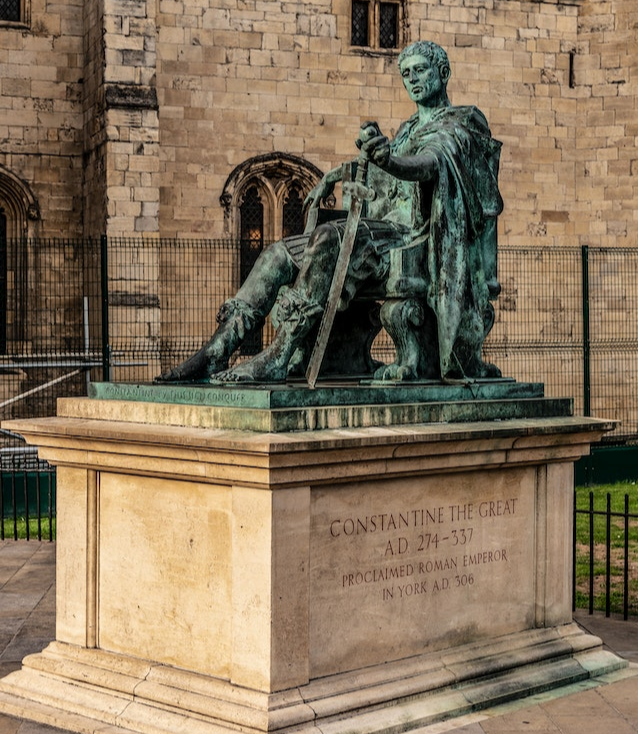Seventh-day Adventists believe that the idea of the church is an important biblical concept.
They see the church as a community of believers who have accepted Jesus as their Lord and Savior. These believers gather together to be a blessing to each other and to others outside their community (Acts 2:40–47).
Here are four things you’ll learn about the church in this post:
- What the church means according to the Bible
- Its purpose
- Its mission
- What it looks like through history
Let’s start with an official statement from Adventism on what church is all about. It reads:
“The church is the community of believers who confess Jesus Christ as Lord and Savior.
In continuity with the people of God in Old Testament times, we are called out from the world; and we join together for worship, for fellowship, for instruction in the Word, for the celebration of the Lord’s Supper, for service to humanity, and for the worldwide proclamation of the gospel.
The church derives its authority from Christ, who is the incarnate Word revealed in the Scriptures. The church is God’s family; adopted by Him as children, its members live on the basis of the new covenant.
The church is the body of Christ, a community of faith of which Christ Himself is the Head. The church is the bride for whom Christ died that He might sanctify and cleanse her. At His return in triumph, He will present her to Himself a glorious church, the faithful of all the ages, the purchase of His blood, not having spot or wrinkle, but holy and without blemish.”
Next, we’ll look at the Bible’s definition of the church.
What is the church according to the Bible?

Photo by Sincerely Media on Unsplash
In the Bible, the word church comes from the Greek word ekklesia, which means “a called out company or assembly.”
And this Greek word is translated from the Hebrew word qahal in the Old Testament Septuagint. Qahal is used to depict the descendants of Abraham and the nation of Israel (Genesis 35:11; 49:6; Exodus 12:6).
Every time the word church is used in the Bible, it always refers to people.
Not church buildings.
Here are some instances when this word is used:
- Referring to a mob (Acts 19:30-41)
- Referring to the children of Israel (Acts 7:38)
- Referring to the body of Christ (Ephesians 1:22; Ephesians 5:25, 32)
And when talking about the body of Christ, the word takes three definitions:
- A local congregation or small group of believers in Jesus (1 Corinthians 1:2; 2 Corinthians 1:1; Galatians 1:1–2)
- The body of individual believers (1 Corinthians 15:9; Galatians 1:13)
- All people in the world who have ever accepted Jesus throughout the ages (Matthew 16:18; Ephesians 5:23–27)
So, according to the Bible, church is a word that refers to people who have believed in Jesus and are in unity of faith and belief.
Bible writers used several illustrations to describe the church. They’re used to show how it functions, its mission and purpose, and its identity in relation to God and unbelievers.
Let’s go through some of them.
The church functions as a human body
Paul illustrates how the church functions by calling it a body. A body with different parts which play different but essential functions. He uses the various parts to illustrate the unique roles of each member of the church (1 Corinthians 12:12–18).
The idea is that just as hands, eyes, feet, or stomach cannot function best without each other, the church needs different people with different gifts to keep it functioning properly.
And this leads to a key biblical point of “fellowship”—a close-knit body of believers working together for the common good.
“But if we walk in the light as He is in the light, we have fellowship with one another, and the blood of Jesus Christ His Son cleanses us from all sin” (1 John 1:7, NKJV).
This fellowship with each other forms the heartbeat of the church. It makes its members part of something greater than themselves.
The church is a building or temple of God
Though the church is not a physical building, believers are referred to as a building or temple of God (1 Corinthians 3:9–17; 6:19).
Just like a building is made of individual bricks or planks of wood, so individual believers in Jesus come together to make the universal church.
And just as a building must have a cornerstone to make it stand, Jesus Christ is the chief cornerstone of the church (Ephesians 2:19–22). Without Him, the church wouldn’t exist in the first place.
In the same way that a house needs to be built on a firm foundation, the church is built on the foundation of the apostles and prophets (Ephesians 2:20).
This refers to the teachings, writings, and leadership of the prophets and apostles, who have learned from Jesus and His Word. They act as leaders and spokespersons for Christ in the church.
The church is the bride of Christ

Photo by Ishan @seefromthesky on Unsplash
Referring to the church as the bride of Christ shows the very special and intimate relationship between Jesus and the church (2 Corinthians 11:2; Ephesians 5:25–32).
Jesus loves His people and sacrificed Himself for us on the cross to ensure that we could be united for eternity in heaven. Just like a husband would naturally love and protect his wife—even when it calls for sacrifice.
In fact, when Jesus said He is going to prepare a place for us in heaven, He was using the language that a groom used in the Jewish culture (John 14:1–3).
After a man proposed to a woman, he would go to his father’s homestead and build an extension to the house. And that would be the house that he would bring his bride to.
So when the house was ready, the wedding would be organized, and he would go for his wife.
That is why when the New Jerusalem comes from heaven in Revelation 21:2, 9, it’s referred to as the bride of the Lamb. It’s the heavenly city that God’s people will live in forever.
What is the purpose of the church?
The Bible shows that the purpose of the church is to provide fellowship and a healthy environment of growth for church members and to share the truth with the world. Let’s look at these various aspects in more detail.
It provides a context for spiritual growth
The church is a setting where believers can grow together and become more like Jesus.
But how is that achieved?
In Ephesians 4:7–16, Paul says that believers have different spiritual gifts. And these gifts, exercised in the church, will benefit the whole body of Christ.
As the members serve each other by exercising their gifts, several things happen:
- Equipping the saints for ministry (service to God and humanity)
- Edification of the body of Christ
- Unity in faith and knowledge of Jesus among the believers
- Growth and maturity in the understanding of truth and in exercising Christ-like love toward others
- Believers growing into “the measure of the stature of the fullness of Christ” (Ephesians 4:13, NKJV)
As we interact and serve each other through our unique gifts, we grow in our relationship with Jesus and become witnesses of His love through our words and lifestyle.
It is the light of the world
Jesus told His followers that they are lights in a world filled with spiritual darkness:
“You are the light of the world. A city that is set on a hill cannot be hidden. Nor do they light a lamp and put it under a basket, but on a lampstand, and it gives light to all who are in the house. Let your light so shine before men, that they may see your good works and glorify your Father in heaven” (Matthew 5:14–16, NKJV).
God’s people are like ambassadors for the kingdom of God.
They show the world what a life transformed by God’s love looks like and help others find this same love.
It is the salt of the earth

Photo by Jason Tuinstra on Unsplash
The church being the salt of the earth refers to its influence in a community and in society. Jesus said:
“You are the salt of the earth; but if the salt loses its flavor, how shall it be seasoned? It is then good for nothing but to be thrown out and trampled underfoot by men” (Matthew 5:13, NKJV).
But why salt?
Salt was used as a preserving agent during Jesus’ time. In the same way that salt prevents perishable things like food from spoiling, the church was to influence society in goodness. Wherever there are believers, a society cannot be completely written off as corrupt.
For example, before the flood, when nearly everyone in the whole world was evil, Noah was “a just man, perfect in his generations” (Genesis 6:5–9, NKJV).
And during the time of Abraham, God promised to save two evil cities—Sodom and Gomorrah—if at least ten righteous people could be found in them (Genesis 18:16–32).
What is the mission of the church?
In His great commission, Jesus made it clear that the mission of the church is to share the gospel with the world:
“Go therefore and make disciples of all the nations, baptizing them in the name of the Father and of the Son and of the Holy Spirit, teaching them to observe all things that I have commanded you; and lo, I am with you always, even to the end of the age” (Matthew 28:19–20, NKJV).
Still today, the church is a witness to the world of the character of God and the wonderful news of the plan of salvation.
And as part of that witness, the church works to alleviate human suffering to whatever degree possible.
That is why the Adventist Church has various ministries that enable them to attend to the spiritual as well as temporal needs of the people. These ministries include:
- The Adventist Development and Relief Agency (ADRA)
- Over 8,000 educational institutes from primary to medical schools
- More than 200 hospitals and health centers
- More than 100 nursing homes
- More than 400 medical clinics
- 11 orphanages
- 16 media centers
No one could do all of these—or any of these—alone.
That’s why God has organized the church, of which Christ is the head (Colossians 1:18). And with Christ as the head of the church, the members seek to emulate Him in ministry (Matthew 25:40).
The church throughout history
God always had a special group of people whom He revealed Himself to—the church. And then, He used that group to reach the rest of the world.
Keep reading to see the various stages of the church.
The church in the Old Testament

Photo by Simon Berger on Unsplash
We can trace God’s chosen people from Adam to Abel and Seth (Genesis 2:7; 4:4; 5:3).
Then all the way to Noah, who was found righteous when the whole world became so corrupt that God mercifully destroyed it with a flood (Genesis 6–8).
Then we get to Abraham, who was called out from his pagan father’s house. Through Him, God wanted to raise up a nation that He could teach His ways. A nation that He could use as a channel of light and blessing to the rest of the world (Genesis 12).
So we have Abraham’s son Isaac. And then Jacob.
Jacob went ahead to have twelve sons, through whom God established the Hebrew nation as promised to Abraham.
For the rest of the Old Testament, the Jews were God’s chosen people (Deuteronomy 7:6–8). They were the church of God. And they were called to bear witness to the world around them.
As God had promised Abraham, all the families of the earth were to be blessed through them (Genesis 12:3).
Anyone who heard about the God of Israel and accepted Him was welcome to join them. That’s why the prophet Isaiah wrote to the Jews saying:
“For My house shall be called a house of prayer for all nations” (Isaiah 56:7, NKJV).
Unfortunately, the Jews did not remain faithful to God and in witnessing to those around them.
Instead of maintaining their uniqueness, they strove to be like all the nations around them. They even worshiped their idols and became very oppressive. Just see accounts like Psalm 78 for a record of their conduct.
But still, God worked with them.
He sent them prophets to warn them, and when they didn’t heed those warnings, they experienced the natural consequences of their actions.
Many times, they saw their mistakes and repented. Though the repentance was often short-lived.
But even when the nation sank into the deepest rebellion against God, there were always some people who remained faithful to God through it all (1 Kings 19:18).
Finally, God sent Jesus among them. And though they had been waiting for Him for a long time as their promised Messiah, they didn’t accept Him.
They were expecting a pompous Messiah who would come to deliver them from their political enemies. Not a humble teacher who had come to save them from their sins.
So they persecuted Him and eventually handed Him over to the Romans to be killed by crucifixion.
But again, there were many who recognized and accepted Him as the Savior of the world.
Like His disciples and other followers.
It’s this group that became God’s faithful church during the life and ministry of Jesus on earth.
The early Christian church
Soon after the ascension of Jesus back to heaven, His followers came together and formed a body of believers.
They prayed together in an upper room as they waited for the fulfillment of Jesus’ promise to send them the Holy Spirit (Acts 1:8, 14)—which occurred on the Day of Pentecost (Acts 2:1).
And that very day, 3,000 new believers were baptized and joined the church (Acts 2:41).
With the rapid growth in numbers, the church members realized the need for a more structured organization. So, they elected church leaders (Acts 6).
Then, persecution broke out against them from the other Jews who had not accepted Christ. And Stephen, one of the leaders, became the first martyr of the apostolic church when he was stoned to death in AD 34 (Acts 7).
When this happened, the special calling that the corporate nation of Israel had enjoyed as God’s chosen people was withdrawn.
Now, God placed it on the New Testament church, which included both Jews and Gentiles (non-Jews) who believed in Jesus.
In other words, this calling was no longer national, or political, or ethnic. From then on, the one thing that mattered was faith in Jesus (Galatians 3:28).
And with the enthusiastic missionary efforts of Paul and the other apostles and believers, Christianity permeated every part of the known world then. It was truly said of them that they “turned the world upside down” (Acts 17:6, NKJV).
Now, let’s take a quick look at how the church progressed from the time of the apostles to God’s church today.
The church in the first centuries
In the late first century and into the next, the church faced persecution from the Roman Empire. But all of this began to change.
In the third century AD, the Roman emperor Constantine became a Christian and declared Christianity the state religion of the Roman Empire.
Though this might seem like a positive change, it led to compromise in the church as pagan practices crept in.
And since this compromised Christianity was now the state religion, people became Christians to gain political prominence rather than to follow Jesus.
While some of the believers remained faithful to the teachings passed down from the apostles, others began to compromise and accept the new politico-religious system.
Thus, two groups began to emerge in the church: those faithful to the original doctrines and those who flexed to accommodate the new system.
Those who compromised gained the favor of the emperors and became strong. They formed the Roman Catholic Church, which eventually reigned across Europe.
The Bible was outlawed for the common people. And what followed was spiritual darkness that covered the land and its people for about thirteen long centuries.
The church in the wilderness
During the time of compromise in the popular Christian church, God’s faithful people are called the church in the wilderness. This concept is drawn from Revelation 12:6, 14, where the church is portrayed as a woman fleeing persecution and going into the wilderness.
Those in this group were few. There were groups like the Waldenses and the Celtic church who held to the Bible as their only authority.
They were unpopular and persecuted by the mainstream mother church. Historians record they were literally “hunted like wild beasts” by their persecutors. Edicts were often given by the papal authorities to kill them, like in the case of the Waldensian and Albigensian massacres.
But even with this great difficulty, they upheld the purpose and mission of the church.
Celtic missionary giants, like Patrick and Columba, planted churches, copied the Bible, and established missionary training schools all over Europe.
And there were the Waldensian missionaries who spread the gospel throughout Europe.
Then came John Wycliffe, “the morning star of the Reformation,” in the thirteenth century.
He translated the Bible from Latin (which was the language of the elite and the clergy) into the language of the common people in England. And as the people read God’s Word, the spiritual darkness began to lift (Psalm 119:130).
With the writings of Wycliffe circulating widely, the Protestant Reformation broke out in Europe about a century later.
They reached John Huss and Jerome, who went on to be huge advocates for reform in Prague, Czech Republic (Bohemia). They were burned to death as martyrs for their faith.
In the mid-thirteenth century, the Gutenberg press was invented, making it possible for many Bibles to be printed.
The Protestant Reformation
Then entered Martin Luther in Germany.
He discovered the Bible while at university, and it became his favorite book. While a Catholic monk, he learned the truth about salvation by faith alone.
As his understanding of salvation grew, he became concerned about the corruption in the Roman Church, especially the selling of indulgences—slips of paper that were supposed to secure forgiveness of sins—either past or future.
In protest, he nailed 95 theses on the door of the chapel at Wittenberg, sparking the Protestant Reformation.
For the next couple of centuries, the light of God’s Word spread steadily across Europe as God raised other reformers.
The church in America—the pilgrims

Photo by Mercedes Mehling on Unsplash
The reformed church of England grew strong during the Reformation. But as reformed as it was, this church wasn’t perfect. It still maintained many of the practices of the Roman Church. And the most disturbing was that everyone was required by law to attend the parish church and follow the Roman rites.
But there were some who wanted to maintain the purity of the Bible’s teachings as passed down from the apostolic church. These people were called the Puritans.
Sadly, the English church began to persecute them because they were not willing to conform.
Since the Puritans valued religious freedom, they crossed the Atlantic to America, a land where they hoped to practice their convictions without interference from the state.
And Roger Williams, a settler in the New World, strongly advocated for religious liberty and freedom of conscience in his little state of Rhode Island. In fact, the principles of religious and civil freedom that he promoted became the foundation of the American republic.
Meanwhile in Europe, papal supremacy came to an end at the end of the sixteenth century.
And the light of God and the Bible began spreading throughout the world through Bible and mission societies.
The Great Awakening, the Millerite Movement, and the Adventist Church
With peace and freedom from persecution, the church began to be lulled into complacency. But in the late 1700s and early 1800s, a great religious awakening broke out as people began studying Bible prophecy—especially the prophecies of Daniel—and recognizing the nearness of Jesus’ second coming.
Preachers like Joseph Wolff spread the message of the Second Advent from Germany to many other parts of Europe.
But the center of this awakening was in the United States, with William Miller as the leader.
Followers of Miller believed that, unlike popular ideas at the time, there wasn’t going to be a temporary millennium of prosperity for the church before the second coming of Jesus.
People from many denominations took part in this movement, known as the Millerite Movement.
Eventually, based on their understanding of Daniel 8:14, they anticipated that Jesus would return in October 1844.
When He didn’t, many were greatly disappointed and left the movement.
But a number went back to studying the Scriptures.
They found that they had made a mistake. Instead of the Daniel 8:14 prophecy referring to the Second Coming, they found it pointed to the start of a judgment in the sanctuary in heaven.
For the next 19 years, they studied further and discovered other forgotten Bible truths, eventually forming the Seventh-day Adventist Church in 1863.
Today, the Seventh-day Adventist Church is a Christian denomination with over 92,000 established local churches around the world and a total membership of more than 21 million people worldwide.
Its members are part of a global faith community that comes together to worship, fellowship, and support each other, just as the apostolic church did.
And though it has adapted to the twenty-first century, it still seeks to fulfill God’s purpose and mission for His church.
Ellen White, one of the founders of the Adventist Church wrote:
“The church is God’s appointed agency for the salvation of men. It was organized for service, and its mission is to carry the gospel to the world.”1
Get connected with the church, God’s followers across the world
The Bible shows us that the church is simply a body of believers in Christ. Believers who are called out to share the truths of the Word of God with the world.
And we’ve seen that the church encompasses God’s followers throughout history. Even amid persecution and compromise, God has led and preserved them.
Finally, we’ve seen how the Adventist Church traces its lineage from God’s church throughout the ages.
But the church on earth is not limited to any one denomination.
Adventists believe that the church is both visible and invisible.2
The visible church refers to the physical representation of the church—its organizational structure, beliefs, and known members who are united to advance its mission through their preaching and Christian conduct.
But God’s true followers are only known to God, and they are found all over the world, some even in the most unlikely places. And God knows all who have accepted Him by faith—the invisible church—in a way that we may never know.
If you’re getting curious about fellowshipping and worshiping with a group of believers, search for an Adventist Church near you.
Before you go, find out what to expect when you visit a Sabbath morning worship service. You will be welcomed by a church family that will be so glad you stopped by.
And you will be glad you did, too!
Want to learn more about God, His truth, and how to be His follower?
Find a Church
If you’re interested in finding a local Adventist church near you, you can use the Adventist Locator provided by the General Conference of Seventh-day Adventists.
- White, Ellen G., Acts of the Apostles (Pacific Press Publishing Association, 1911), p. 9. [↵]
- “The Nature of the Church,” Ministry Magazine. [↵]
Related Articles
More Answers
What Adventists Believe about The Experience of Salvation?
The Seventh-day Adventist Church believes that salvation is a gift that anyone can receive through faith in Jesus Christ, the Son of God. When we accept His sacrificial death in our place, He saves us from the penalty and power of sin (or evil), which prevents us from experiencing true freedom.
What do Seventh-day Adventists Believe about the Life, Death, and Resurrection of Jesus?
Jesus Christ, a person who lived in first-century Palestine, is the foundation of the Adventist faith. This is because it’s only through the life, death, and resurrection of Jesus that any of us have hope of life beyond the toil, suffering, and death of this world.
What do Seventh-day Adventists Believe about The Great Controversy?
The “Great Controversy” is the phrase Seventh-day Adventists typically use to describe the cosmic spiritual conflict between the forces of good (God) and the forces of evil or sin (Satan/the devil).
What do Seventh-day Adventists Believe about Creation?
Seventh-day Adventists believe that God is the creator of our world. They come to this conclusion from the first book of the Bible—Genesis. The account there tells us that God took six literal days to form the earth and all it contains, including us humans.
What Do Seventh-day Adventists Believe about the Father?
Like most Protestant Christians, Seventh-day Adventists believe in God the Father as part of the Godhead. We call Him Father because of His role towards Jesus. Jesus Himself encouraged us to also call Him Father.
What do Seventh-day Adventists Believe about Sin and the Nature of Humanity?
Seventh-day Adventists believe that humanity was created perfect and that, at our very core, we crave this kind of perfection and unity with God. But unfortunately, the Bible teaches that we chose to be wise in our own eyes and disobey God, which led to a natural tendency to be sinful, evil, and selfish.
What Do Seventh-Day Adventists Believe about God the Holy Spirit?
Besides believing in the full divinity of God the Father and God the Son, Adventists also believe in the full divinity of God the Holy Spirit. This post will go over what the Bible says about the Holy Spirit. You’ll learn:
What Do Seventh-day Adventists Believe about God the Son?
Seventh-day Adventists believe that Jesus is fully God, being one of the members of the Trinity. And that He plays a central role in it as the Son of God.
What Seventh-day Adventists Believe about the Trinity
How can Father, Son, and Holy Spirit all be one God? Find out as you learn what the Bible has to say about the Trinity.
What Seventh-day Adventists Believe about the Bible
The Bible forms the foundation for all that Seventh-day Adventists believe and teach. It reveals God to us and is our final authority on all issues relating to morals, doctrine, salvation, and the very nature and purpose of life itself (Isaiah 8:20).
Didn’t find your answer? Ask us!
We understand your concern of having questions but not knowing who to ask—we’ve felt it ourselves. When you’re ready to learn more about Adventists, send us a question! We know a thing or two about Adventists.














